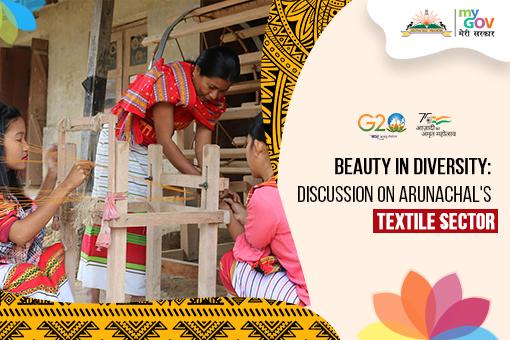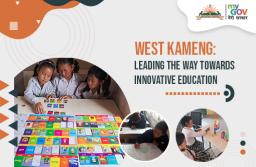Arunachal Pradesh traditionally known for its mesmerizing landscape is also home to a rich textile and handicraft industry. And because the state houses more than 20 major tribes and 100 sub-tribes, it is known for its diverse range of handloom and handicrafts, which are a reflection of the region's rich cultural heritage and traditional practices.
Handloom & Weaving: The handloom weaving industry is a significant source of employment in Arunachal Pradesh. The state is renowned for the excellent handmade textiles crafted by skilled weavers. The different tribes of Arunachal Pradesh weave using a variety of methods and designs to produce a wide range of textiles. Every tribe in the state has a distinctive weaving technique that is passed down from generation to generation. Each piece is distinctive and a testament to the weavers' abilities owing to the elaborate designs and patterns used in the weaving procedures.
The handloom weaving industry has enormous potential in Arunachal Pradesh, and many organizations and government bodies are working towards preserving and promoting this traditional craft. The state government has established a Handloom and Handicrafts Development Corporation to provide financial assistance, training, and marketing support to the weavers. The corporation also provides raw materials, looms, and other equipment to the weavers to create quality products.
Handicrafts: Arunachal Pradesh is also known for its diverse range of handicrafts, ranging from woodcarving to basketry. Each tribe in the state has its unique craftsmanship, creating beautiful products that showcase their traditional practices and cultural heritage. Some of the popular handicrafts of Arunachal Pradesh include bamboo and cane products, pottery, woodcarving, and beadwork. Pottery is another traditional craft that has been practiced in Arunachal Pradesh for generations. Woodcarving is a traditional craft that is practiced by many tribes in Arunachal Pradesh with beautiful patterns and beadwork is another popular craft in Arunachal Pradesh and is typically used to decorate clothes, bags, and jewelry.
Marketing and Export Opportunities:
Arunachal Pradesh's textile and handicraft industry has great potential to grow and expand. The state government has taken many initiatives to market and promote these crafts, particularly at the national and international levels, after realizing their full potential. The government has established several emporiums that sell these products and also participates in various trade fairs and exhibitions to showcase these crafts.
Furthermore, several NGOs and private organizations are working to create long-term employment opportunities for local artisans. These organizations train and empower artisans to produce high-quality goods while also assisting them in gaining access to markets.
MyGov Arunachal Pradesh invites citizens to share their valuable opinion and suggestions on how we can promote and market these local crafts to increase their reach and visibility.













BrahmDevYadav 2 years 5 months ago
How can we improve textile industry?
1.Estimate and arrange funds adequately.
2.Add new selections regularly.
3.Website for E-commerce.
4.Customer referrals.
5.Collaboration with other companies.
6.Make the most of the current market.
7.Competition investigations.
8.Bottom line.
BrahmDevYadav 2 years 5 months ago
Why is textile industry unique?
It is the only industry in the country that is self reliant and produces from raw material to highest value-added products i.e. complete in the value chain.
BrahmDevYadav 2 years 5 months ago
What are the three main ways the textile industry can influence the environment?
The main environmental problems caused by the textile industry include water pollution, air pollution and solid waste pollution.
BrahmDevYadav 2 years 5 months ago
Why is textile sector booming?
The textile industry in India is particularly robust due to the wide diversity of natural and synthetic fibers and yarns. Compared to sectors such as heavy equipment, vehicles etc., the textile industry in India is technologically advanced and capital intensive.
BrahmDevYadav 2 years 5 months ago
What are two benefits of textile industry?
Human advantages include the use of textiles for clothing and shelter, dental and medical devices and protective firefighting and military clothing and gear. Textile fibers can also be found in computer chips and optical fibers.
BrahmDevYadav 2 years 5 months ago
How can textile industry be sustainable?
Sustainability in textiles implies consuming green clothing. For this, one has to rely on specific brands using fabrics from recycled materials or innovative natural fibers. At times, we may have heard to avoid certain types of cotton or wool and instead choose fibers such as lyocell or linen.
BrahmDevYadav 2 years 5 months ago
How can we improve the quality of textiles?
Prepare and carry out a regular maintenance schedule for equipment. Cutting accuracy is the next most crucial factor. The cut components has to be checked specifically for matching cut panels to the original pattern, shade variance, fabric-related flaws etc.
BrahmDevYadav 2 years 5 months ago
What is the minimum investment for textile industry?
For the medium scale textile industry, the investment is allowed up to Rs. 10 crores.
BrahmDevYadav 2 years 5 months ago
What is the scope of textile?
Students can apply for the sector, such as fashion clothing, fibre manufacturing, garment colouring and industrial machinery designing.
BrahmDevYadav 2 years 5 months ago
Is textile a good investment?
The textile industry is one of the biggest industries in India. It contributes about 2% of the country's GDP and is the second largest employment source. There are several companies in the textile sector providing good results to investors.